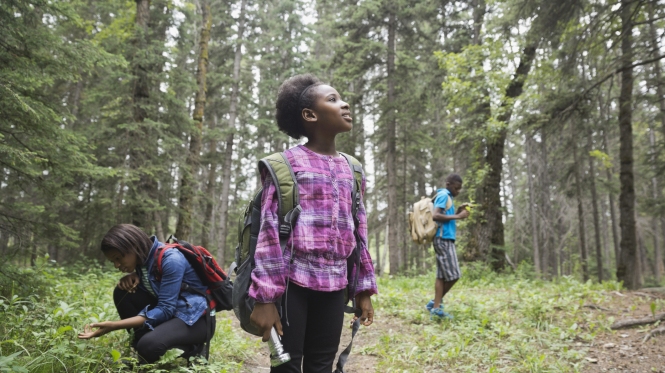
Part Two of WP’s Summertime Safety Tips is here! This week’s theme: The Great Outdoors!
Bug Bites & Stings
Bug bites and stings are usually just annoying, causing temporary discomfort and pain, but no serious or lasting health problems. You can help prevent your child from getting a bug bite or sting by regularly vacuuming around the house, spraying your children with insect repellent when they go outside, staying on the trail (if your family goes hiking), wearing gloves while gardening, and reminding them to keep away from bee/wasp nests outside.
- How to Treat Common Summer Bug Bites & Stings:
- If stung by a bee or wasp, remove the bee’s stinger as quickly as possible using a scraping motion, without pinching the venom sac at the end of the stinger (note: wasps will not leave venom sacs on their stingers). Wash the area carefully with soap and water two to three times a day until the skin is healed. Use ice packs and ibuprofen for pain.
- If your child has had an allergic reaction to a bee or wasp sting in the past, see your health care provider for a prescription for an epinephrine auto-injector (Epi-Pen).
- If bitten by a spider, wash the area carefully with soap two to three times daily until the skin heals, and utilize cold compresses and ibuprofen for pain and discomfort. (Note: most every spider bite you/your child will get in North America is harmless)
- If bitten by a tick, or if you find a tick on your child, use tweezers to grasp the tick firmly at its head/mouth, next to the skin. Pull firmly and steadily upward on the tick until it lets go (do NOT twist or jerk the tick), then swab the bite site with rubbing alcohol.
- Do NOT use petroleum jelly or a lit match to kill and/or remove a tick. These methods may cause the tick to burrow deeper into your child’s skin
- If stung by a bee or wasp, remove the bee’s stinger as quickly as possible using a scraping motion, without pinching the venom sac at the end of the stinger (note: wasps will not leave venom sacs on their stingers). Wash the area carefully with soap and water two to three times a day until the skin is healed. Use ice packs and ibuprofen for pain.
Camping Safety
Camping can be one of the most enjoyable and rewarding bonding times with your family, but always be prepared for a trip to the woods!
- Plan ahead and be aware of camping safety issues that apply to your campsite, like bug bites/stings, plants that can cause rashes, and exposure to heat/cold/wind/water/etc.
- Look online for lists of go-to, essential camping gear and first aid equipment. It’s always better to be prepared and have a little extra to pack in the care then realize you don’t have the proper tools in case of an emergency.
- Be sure to bring/pack lots of clean water from home for those sunny, hot days on the trail; cover the whole family in sunscreen, and wear skin protection like hats and lightweight cotton clothing
- Even though it’s summer, the nights can get pretty cold when camping. Be sure to pack long sleeved clothing in case it gets chilly.
- Teach your kids how to recognize landmarks at the campsite and on hikes to prevent them from getting lost. Teach them to remain where they are and stay calm if they are lost, and be sure to pack along some whistles for them to carry and use should they get separated from the group (three whistle blasts = universal help signal).
- Be sure to scout your site before/as you set up camp for natural hazards, like bugs nests, ad other materials like trash and broken glass left behind by others
- And ALWAYS be sure to scout your campsite again when your family packs up to go home. Be courteous to the next campers, and to the natural world around you, by leaving your campsite in a better state than you found it! #LeaveNoTrace
Fire Safety
Fire is present in several summer activites: grills, fire-pits in the back yard, tiki torches, s’mores over a campfire, etc. But be sure the whole family knows how to stay safe around fire, in its many forms, this summer!
- Always keep matches and lighters out of children’s reach. Store flammable materials, such as gasoline, kerosene, and cleaning supplies, outside of your home and away from kids.
- If you’re camping and plan to build a firepit, look for a clearing and/or previous campers’ firepits. During fire-hazard period and dry seasons, use portable stoves rather than campfires.
- Have a designated adult be the “Fire Marshal” if your family is around a firepit/campfire, and remind your children that only the fire marshal can add fuel to, mess with, or get close to the fire. Be sure to establish a “Fire Circle” as well at a radius of about one or two yards, depending on the fire’s size and the age of your children.
In the case of an emergency while outdoors this summer, it’s important to remain calm. Always stay on the safe side when setting boundaries for family camping; the more remote your location, the more care you should take in choosing your activities. Good preparation before a trip can help you/your family keep a level head should an emergency arise, so be sure to do your homework beforehand and make sure your children/family know outdoor summer safety as well!









You must be logged in to post a comment.